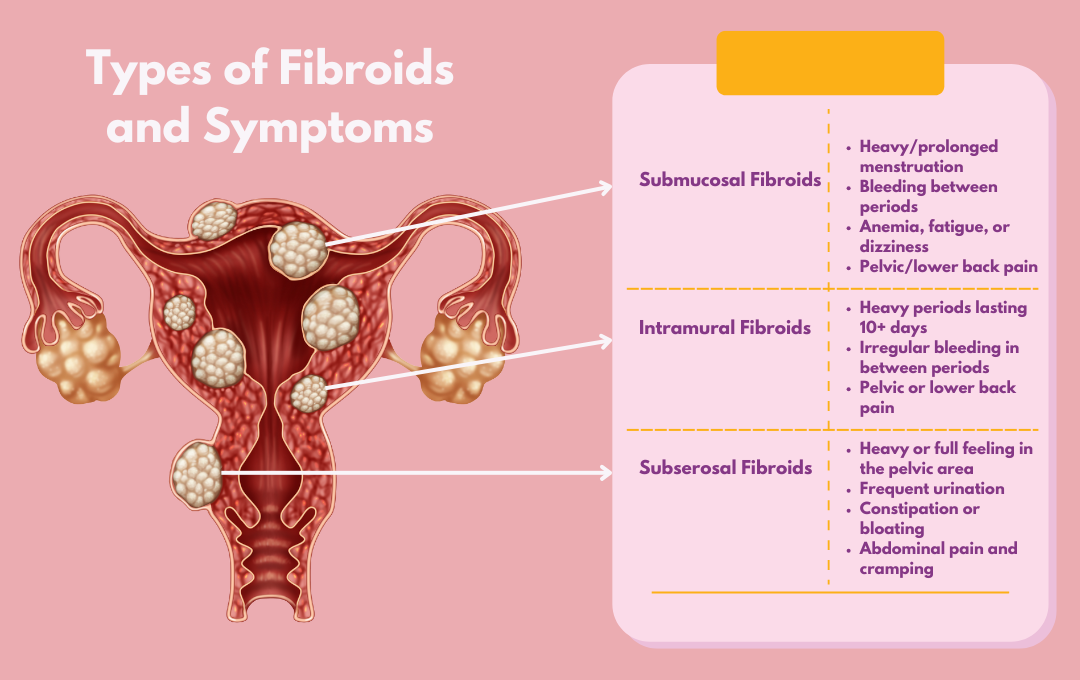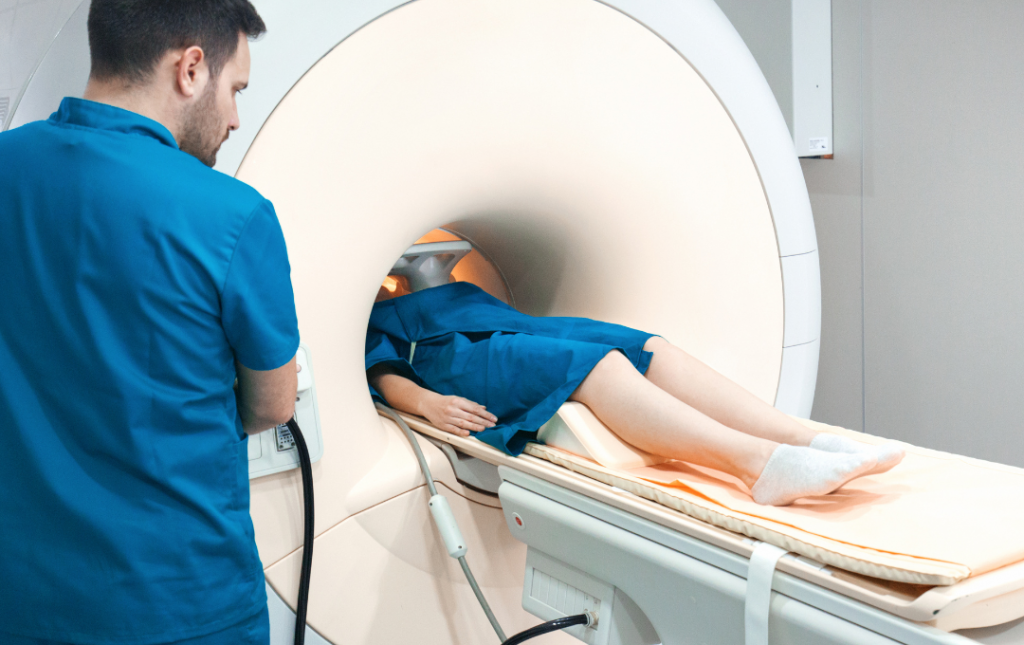
Fibroids are noncancerous growths that develop in the uterus and affect over 26 million women in the United States. While most fibroids grow within the main body of the uterus, some can form in the cervix, the lower part of the uterus that connects to the vagina. These fibroids are known as cervical fibroids.
Like other fibroids, cervical fibroids can cause issues such as:
- Heavy or irregular menstrual bleeding
- Pelvic pain
- Difficulty getting pregnant.
In this blog, we’ll discuss what cervical fibroids are and review their symptoms, diagnosis, potential complications, and available treatment options.
Cervical Leiomyomas
Cervical fibroids, also known as cervical leiomyomas, are a less common type of fibroid that grows near the cervix. Based on their location, fibroids can develop in different areas of the uterus. There are three types of fibroids:

All fibroids consist of smooth muscle cells and fibrous connective tissue. Like other fibroids, cervical fibroids can occur individually or in a cluster. In some cases, cervical fibroids may grow out of the cervix into the vagina.
The exact cause of fibroids is still unknown. One possible explanation is that a specific gene may play a role in their development, but further research is necessary to understand this fully.
Cervical Fibroid Symptoms

Many women mistake painful, heavy periods as being “just a part of life”; which of course, isn’t the case. Cervical fibroid symptoms aren’t specifically unique when compared to other types of fibroids; therefore, self-diagnosing yourself is almost impossible. However, there are a few signs of cervical fibroids that may be more apparent, such as:
- Pain during or after intercourse
- Severe pelvic pressure
- Discomfort when inserting a tampon or menstrual cup
- Heavy, prolonged menstruation Irregular bleeding between cycles
- Difficulty emptying your bladder
- Frequent urination
- Chronic urinary tract infections
If you’re experiencing any of the above signs of cervical fibroids, it’s important to consult a specialist as soon as possible. Women need to be aware of the fact that monthly periods shouldn’t be negatively impacting your daily life. If they are becoming overwhelming, you need to seek help.
Remember to track any period changes so you can accurately inform your doctor. In addition to painful symptoms, cervical myomas can sometimes lead to difficulties getting pregnant, miscarriages, and complications during labor. It’s important to consult a fibroid specialist if you think you may have cervical fibroids.
How Are Cervical Myomas Diagnosed?

A pelvic exam, an ultrasound, or an MRI can diagnose cervical fibroids. During a pelvic exam, your doctor may be able to detect fibroids depending on their size and location. If the fibroid is near the cervix, an ultrasound can provide information about size, number and location. An MRI can provide a more comprehensive view of the uterus.
Can a Pap Smear Detect Fibroids?
A pap smear detects cervical cancer and is not used to diagnose fibroids. Fibroids are typically diagnosed through other methods, such as a pelvic exam, ultrasound, or MRI.
A pelvic exam, where a pap smear is typically done, is an opportunity to discuss any changes in your period with your doctor. They can look for unusual growths on your cervix, such as cervical fibroids.
Are Cervical Fibroids Dangerous?
Cervical fibroids, while typically noncancerous, can cause a range of symptoms that affect quality of life.
These symptoms can include painful intercourse, heavy or prolonged menstrual bleeding, and, in some cases, may contribute to fertility challenges.
Heavy or prolonged bleeding can sometimes lead to anemia. Anemia occurs when the body has a lower number of healthy red blood cells which is essential to carry oxygen. This can lead to fatigue and other symptoms.
The body can usually adjust to mild anemia. However, if left untreated, severe anemia can lead to serious health problems.
If you are experiencing heavy bleeding or other concerning symptoms, it’s important to consult with a healthcare professional.
Can Fibroids Lead to Cervical Cancer?

Fibroids do not lead to cervical cancer. However, according to the Office on Women’s Health, less than one percent of fibroids are found to be cancerous. While rare, fibroids are more likely to be cancerous in women who have gone through menopause. A common symptom of a cancerous fibroid in postmenopausal women is unexpected vaginal bleeding. If you have gone through menopause and still experience vaginal bleeding, see a doctor right away.
Cervical Fibroid Management and Treatment

While online resources offer advice on managing fibroid symptoms, you should discuss your fibroids with your doctor or fibroid specialist for an accurate diagnosis. They can also discuss FDA-approved treatments that effectively reduce fibroid symptoms. These fibroid treatments include the following:
Uterine fibroid embolization (UFE)
UFE is a minimally invasive procedure where a specialist, usually an interventional radiologist, uses ultrasound technology to locate fibroids and then blocks the arteries supplying blood to them. This causes the fibroids to shrink and die over time. This procedure may be an option for women with fibroids who are considering pregnancy.
Myomectomy
Myomectomy is the surgical procedure to remove fibroids, offering another option for women wish to preserve their fertility. However, it requires surgical incisions which require a longer recovery period.
Hysterectomy
Hysterectomy, the surgical removal of the uterus, is sometimes recommended for fibroids. Because this procedure is irreversible, women should carefully explore all other treatment options before deciding on a hysterectomy. Hysterectomy may be recommended for severe fibroids when other options are unsuitable, and it is also used to treat conditions like uterine cancer.
Hormone Medications
Hormones can affect fibroid growth which is why postmenopausal women often don’t experience many fibroid symptoms. Because hormone medications can have complex effects on fibroids, always discuss them with your doctor before using hormones to manage fibroid symptoms.
Ablation
Ablation is a non-surgical procedure that uses heat to shrink fibroid tissue. This procedure focuses on reducing symptoms rather than completely removing fibroids.
Next Steps Managing Fibroids
If you are dealing with cervical fibroids, your next step should be consulting with a fibroid specialist. The Fibroid Fighters Foundation provides helpful resources about cervical fibroids.
We’re dedicated to helping women making informed healthcare decisions.
For more information on fibroids, symptoms, and treatment options, contact us at 855-455-5262 or email us at [email protected].







